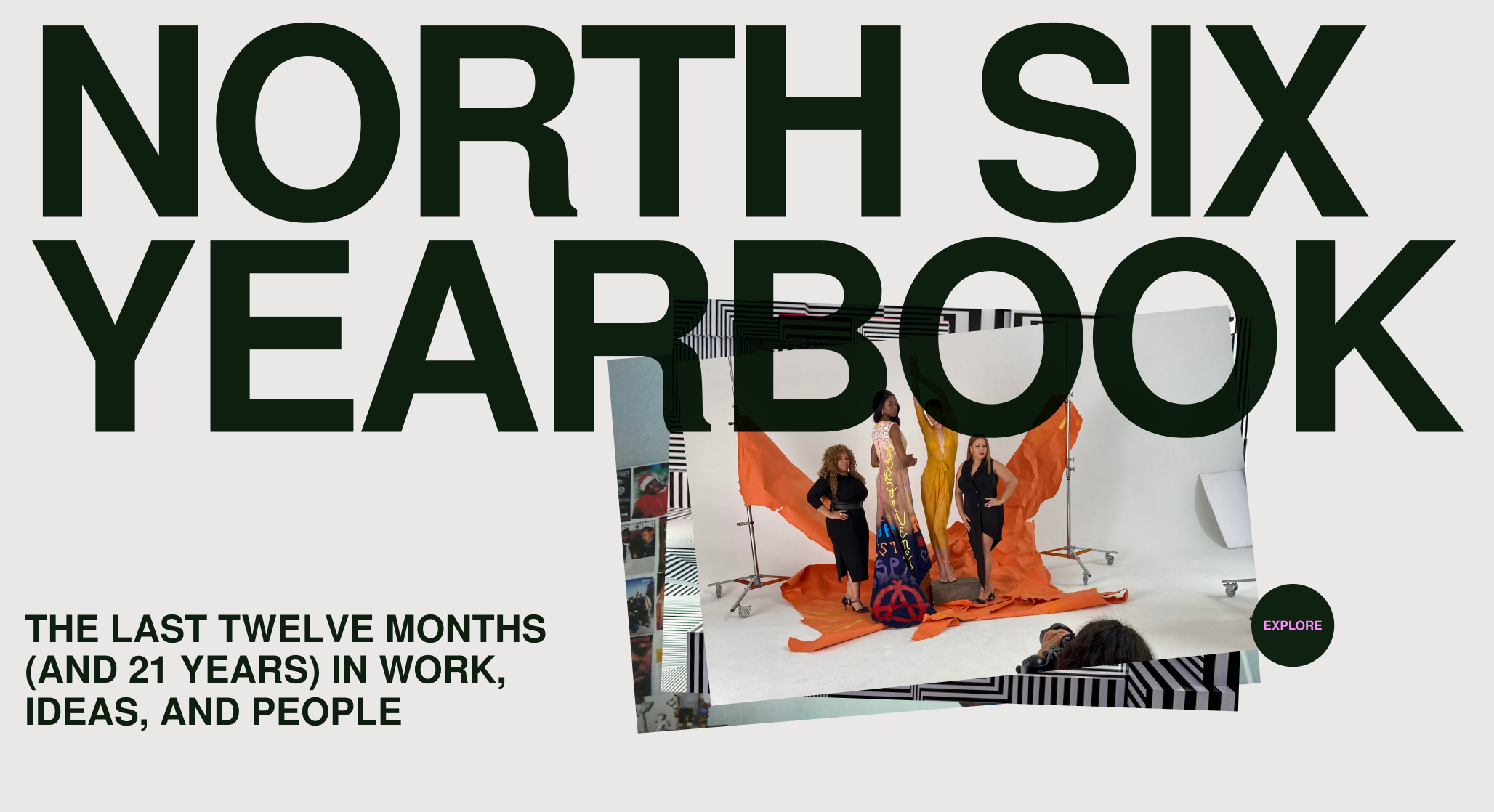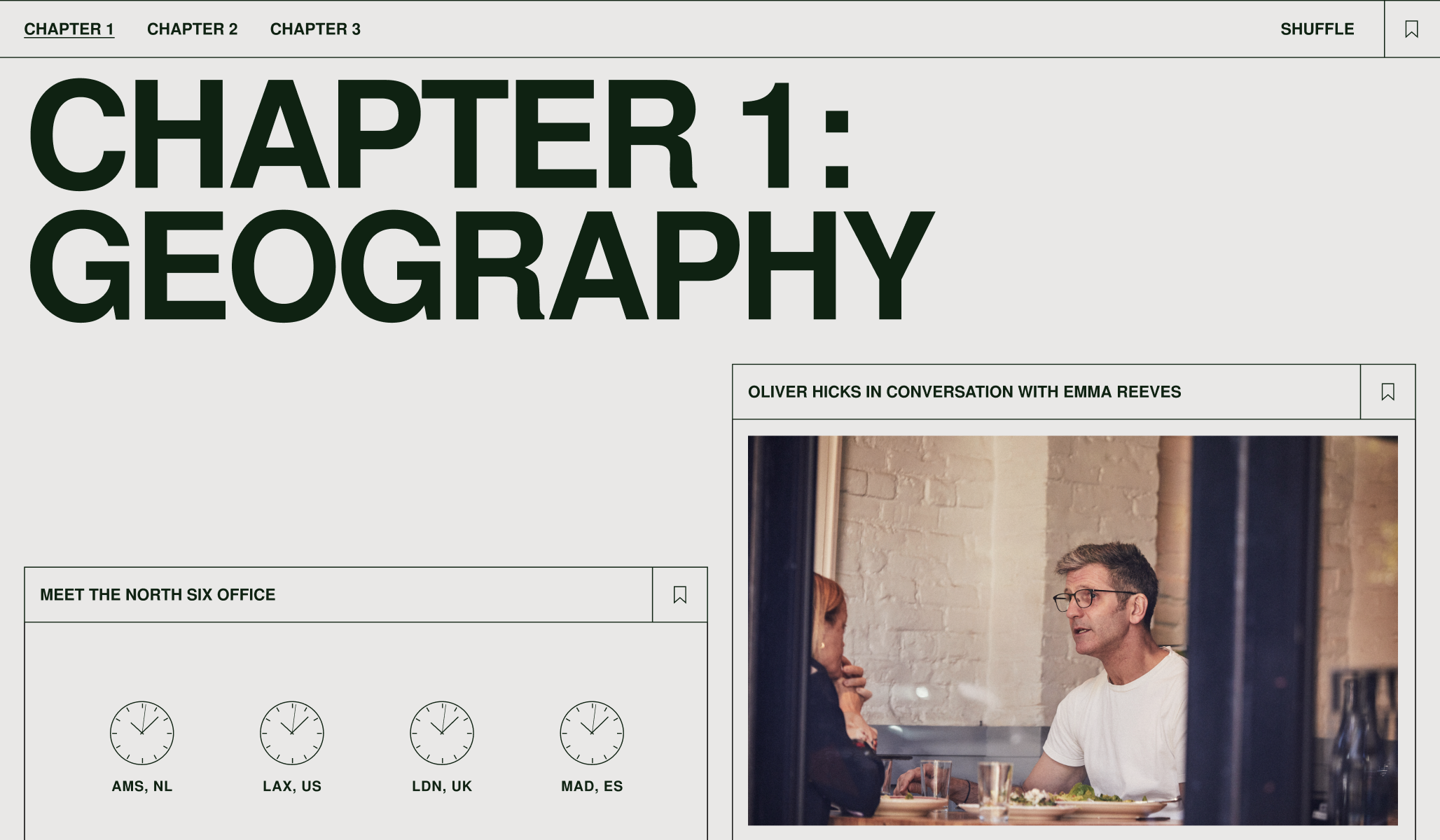

North Six Yearbook
North Six are a global collective of content creators, producers and thinkers renowned for their innovative work with fashion and lifestyle brands. We created a digital editorial platform that goes behind the scenes to document their inspiring journey through the work, ideas, and people who make them who they are.
North Six are a global collective of content creators, producers and thinkers renowned for their innovative work with fashion and lifestyle brands. We created a digital editorial platform that goes behind the scenes to document their inspiring journey through the work, ideas, and people who make them who they are.
Their services are eclectic; they work with stills, motion, experiences, PR, and influencer marketing. Behind their work lies the belief that advertising should be meaningful, exciting and, perhaps most importantly, joyful. As a collective, they are testament to the fact that if you bring together talented people from diverse areas of expertise, the work will shine.



The brief
North Six wanted to celebrate their 21st anniversary with a novel digital experience. We created a dynamic publication in the spirit of a yearbook: a reflective anthology of the work, places, people, and ideas important to them.
The purpose of the Yearbook is to showcase North Six's rich offering as a collective, by illuminating the stories of the people who make up the collective in conjunction with the high quality work they produce.
North Six's inspiration for the Yearbook came from large format print publications. Our goal was to create a platform that mirrored the experience of reading these physical books, whilst bringing in elements of playfulness and interaction with digital functionality.
The Yearbook also needed to give precedent to the editorial content, by presenting the mix of media that make up their stories in a cohesive manner.



Nyc, USA
Inspired by print
We created a digital experience inspired by the rich history of large format print publications in design, fashion and photography.
The power behind coffee table books lies in their ability to create an individual experience for each person. They're not intended to be read in the same manner as a traditional book; they are eclectic; using moments of impact and impression that speak to a person with 5 or 50 minutes of time.
The first impression is shaped by the front cover. The text is often bold and simplistic, with imagery that sets the tone for what will be discovered inside. Our digital Yearbook begins with a heavy-duty font against a subtle off-white background mimicking high quality print paper. Beneath, images stack over each other, offering a snapshot of the stories that are contained within.
We like to think that you can learn something about a creative by the book that sits centre-place on their desk. If you leafed through it, it would fall open at the sections that have left an impression on them, with scraps of paper, old receipts or out-of-date train tickets marking the pages that are returned to time after time.
We wanted to extend this degree of personalisation to the Yearbook. We created the ability to bookmark your favourite stories with a simple icon that is then reflected in the navigation bar, just like how you would see those scraps of paper sticking out the top of a coffee table book.
A bold approach to typography
We took a minimalist approach to typography that increases readability, whilst interactive elements elevate the experience beyond what is possible in print.
As a digital experience, the Yearbook needed to let the quality of the editorial content shine. We created a hierarchical system that clearly defined different written elements, from subtitles, to summary copy. For titles, we took inspiration from newspaper tabloids and traditional graphic design publications, with a bold, capitalised version of their brand font. For the body copy, we took a pared-back, single-column approach that eliminates distractions and allows the user to become immersed in the story.
However, we also wanted to add a level of interactivity for certain elements within the copy to bring the stories alive. We placed quotes in blocks of black with North Six's vibrant pink for the type colouring to contrast with the main body copy. For these blocks, we created an interaction that illuminates each word as the user scrolls, giving the sense that the quotes are being spoken aloud as the user reads.

I think in LA you can marinate something properly, in a way that you can't in other places.

An ecosystem of mixed media
The Yearbook needed to house multiple, contrasting forms of content. We created a cohesive experience where each element works in harmony to tell the North Six story.
The stories North Six wanted to feature included articles, timelines, interviews, essays, scrapbooks, location overviews and sustainability reports.
The formatting for this content was also diverse, with video, static imagery, and even audio. Within the written content there was further segmentation, with interview transcripts, long-form copy from North Six creatives, and engaging copywriting from David Michon. For the yearbook to be successful, all of this content needed to feel like a cohesive experience.
We achieved this by making sure that the eclectic mix of content worked in harmony to tell the story it serves. For example, in an interview between co-founder Oliver Hicks and creative director Emma Reeves, the page begins with a short, repeating clip of the two participants sitting at a table in conversation. This instantly shows the user the dialogical nature of the article, giving context to the content that follows.
As the user scrolls down, they are presented with the written transcript, shown in its most basic, textual form. When the user hovers over this text, the cursor changes to give the option of listening to an audio clip of the conversation; if they click, the transcript fades out of focus, allowing them to become fully immersed in the voices that make up the conversation.






